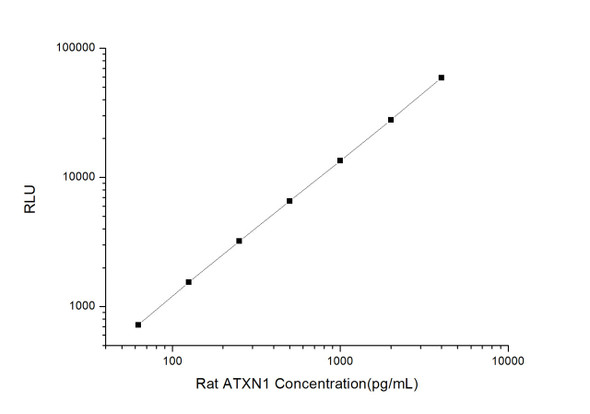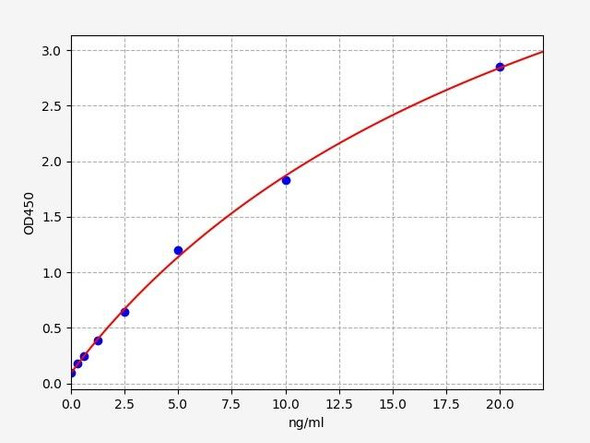Human Epigenetics and Nuclear Signaling ELISA Kits
Human ATXN1 (Ataxin 1) CLIA Kit (HUES00369)
- SKU:
- HUES00369
- Product Type:
- ELISA Kit
- ELISA Type:
- CLIA Kit
- Size:
- 96 Assays
- Sensitivity:
- 37.5pg/mL
- Range:
- 62.5-4000pg/mL
- ELISA Type:
- Sandwich
- Reactivity:
- Human
- Sample Type:
- Serum, plasma and other biological fluids
- Research Area:
- Epigenetics and Nuclear Signaling
Description
| Assay type: | Sandwich |
| Format: | 96T |
| Assay time: | 4.5h |
| Reactivity: | Human |
| Detection method: | Chemiluminescence |
| Detection range: | 62.50-4000 pg/mL |
| Sensitivity: | 37.50 pg/mL |
| Sample volume: | 100µL |
| Sample type: | Serum, plasma and other biological fluids |
| Repeatability: | CV < 15% |
| Specificity: | This kit recognizes Human ATXN1 in samples. No significant cross-reactivity or interference between Human ATXN1 and analogues was observed. |
This kit uses Sandwich-CLIA as the method. The micro CLIA plate provided in this kit has been pre-coated with an antibody specific to Human ATXN1. Standards or samples are added to the appropriate micro CLIA plate wells and combined with the specific antibody. Then a biotinylated detection antibody specific for Human ATXN1 and Avidin-Horseradish Peroxidase (HRP) conjugate are added to each micro plate well successively and incubated. Free components are washed away. The substrate solution is added to each well. Only those wells that contain Human ATXN1, biotinylated detection antibody and Avidin-HRP conjugate will appear fluorescence. The Relative light unit (RLU) value is measured spectrophotometrically by the Chemiluminescence immunoassay analyzer. The RLU value is positively associated with the concentration of Human ATXN1. The concentration of Human ATXN1 in the samples can be calculated by comparing the RLU of the samples to the standard curve.
| UniProt Protein Function: | ataxin-1: spinocerebellar ataxia type 1 (SCA1) protein. Expansion of CAG repeats in the SCA1 gene results in an abnormally long polyglutamine tract in the protein, causing polyglutamine-induced neurodegeneration. 14-3-3 and Akt kinase stabilize both wild-type and mutant forms of ataxin-1. The expansion of the polyglutamine tract may alter this function. |
| UniProt Protein Details: | Protein type:Nuclear export; RNA-binding Chromosomal Location of Human Ortholog: 6p23 Cellular Component: cytoplasm; intracellular membrane-bound organelle; nuclear inclusion body; nuclear matrix; nuclear RNA export factor complex; nucleoplasm; nucleus Molecular Function:chromatin binding; DNA binding; identical protein binding; poly(rG) binding; poly(U) binding; protein binding; protein C-terminus binding; protein self-association Biological Process: adult locomotory behavior; alveolus development; negative regulation of insulin-like growth factor receptor signaling pathway; negative regulation of phosphorylation; negative regulation of transcription from RNA polymerase II promoter; negative regulation of transcription, DNA-dependent; nuclear export; positive regulation of transcription from RNA polymerase II promoter; regulation of excitatory postsynaptic membrane potential; RNA processing; transcription, DNA-dependent; visual learning Disease: Spinocerebellar Ataxia 1 |
| NCBI Summary: | The autosomal dominant cerebellar ataxias (ADCA) are a heterogeneous group of neurodegenerative disorders characterized by progressive degeneration of the cerebellum, brain stem and spinal cord. Clinically, ADCA has been divided into three groups: ADCA types I-III. ADCAI is genetically heterogeneous, with five genetic loci, designated spinocerebellar ataxia (SCA) 1, 2, 3, 4 and 6, being assigned to five different chromosomes. ADCAII, which always presents with retinal degeneration (SCA7), and ADCAIII often referred to as the `pure' cerebellar syndrome (SCA5), are most likely homogeneous disorders. Several SCA genes have been cloned and shown to contain CAG repeats in their coding regions. ADCA is caused by the expansion of the CAG repeats, producing an elongated polyglutamine tract in the corresponding protein. The expanded repeats are variable in size and unstable, usually increasing in size when transmitted to successive generations. The function of the ataxins is not known. This locus has been mapped to chromosome 6, and it has been determined that the diseased allele contains 41-81 CAG repeats, compared to 6-39 in the normal allele, and is associated with spinocerebellar ataxia type 1 (SCA1). At least two transcript variants encoding the same protein have been found for this gene. [provided by RefSeq, Jan 2010] |
| UniProt Code: | P54253 |
| NCBI GenInfo Identifier: | 206729854 |
| NCBI Gene ID: | 6310 |
| NCBI Accession: | P54253. 2 |
| UniProt Secondary Accession: | P54253,Q17S02, Q9UJG2, Q9Y4J1, |
| UniProt Related Accession: | P54253 |
| Molecular Weight: | 86,923 Da |
| NCBI Full Name: | Ataxin-1 |
| NCBI Synonym Full Names: | ataxin 1 |
| NCBI Official Symbol: | ATXN1 |
| NCBI Official Synonym Symbols: | ATX1; SCA1; D6S504E |
| NCBI Protein Information: | ataxin-1 |
| UniProt Protein Name: | Ataxin-1 |
| UniProt Synonym Protein Names: | Spinocerebellar ataxia type 1 protein |
| Protein Family: | Ataxin |
| UniProt Gene Name: | ATXN1 |
| UniProt Entry Name: | ATX1_HUMAN |
As the RLU values of the standard curve may vary according to the conditions of the actual assay performance (e. g. operator, pipetting technique, washing technique or temperature effects), the operator should establish a standard curve for each test. Typical standard curve and data is provided below for reference only.
| Concentration (pg/mL) | RLU | Average | Corrected |
| 4000 | 55542 62620 | 59081 | 59046 |
| 2000 | 25945 29773 | 27859 | 27824 |
| 1000 | 14484 12484 | 13484 | 13449 |
| 500 | 6219 6991 | 6605 | 6570 |
| 250 | 3313 3173 | 3243 | 3208 |
| 125 | 1623 1539 | 1581 | 1546 |
| 62.50 | 719 791 | 755 | 720 |
| 0 | 35 35 | 35 | -- |
Precision
Intra-assay Precision (Precision within an assay): 3 samples with low, mid range and high level Human ATXN1 were tested 20 times on one plate, respectively.
Inter-assay Precision (Precision between assays): 3 samples with low, mid range and high level Human ATXN1 were tested on 3 different plates, 20 replicates in each plate.
| Intra-assay Precision | Inter-assay Precision | |||||
| Sample | 1 | 2 | 3 | 1 | 2 | 3 |
| n | 20 | 20 | 20 | 20 | 20 | 20 |
| Mean (pg/mL) | 193.86 | 428.13 | 1779.58 | 195.96 | 398.29 | 1940.34 |
| Standard deviation | 22.26 | 45.34 | 161.59 | 16.95 | 31.70 | 132.33 |
| C V (%) | 11.48 | 10.59 | 9.08 | 8.65 | 7.96 | 6.82 |
Recovery
The recovery of Human ATXN1 spiked at three different levels in samples throughout the range of the assay was evaluated in various matrices.
| Sample Type | Range (%) | Average Recovery (%) |
| Serum (n=5) | 100-112 | 106 |
| EDTA plasma (n=5) | 89-102 | 96 |
| Cell culture media (n=5) | 95-109 | 101 |
Linearity
Samples were spiked with high concentrations of Human ATXN1 and diluted with Reference Standard & Sample Diluent to produce samples with values within the range of the assay.
| Serum (n=5) | EDTA plasma (n=5) | Cell culture media (n=5) | ||
| 1:2 | Range (%) | 96-113 | 88-104 | 92-104 |
| Average (%) | 104 | 95 | 98 | |
| 1:4 | Range (%) | 94-107 | 100-116 | 93-106 |
| Average (%) | 100 | 106 | 100 | |
| 1:8 | Range (%) | 87-102 | 91-105 | 90-101 |
| Average (%) | 93 | 97 | 96 | |
| 1:16 | Range (%) | 90-105 | 95-107 | 98-110 |
| Average (%) | 98 | 102 | 105 |
An unopened kit can be stored at 4°C for 1 month. If the kit is not used within 1 month, store the items separately according to the following conditions once the kit is received.
| Item | Specifications | Storage |
| Micro CLIA Plate(Dismountable) | 8 wells ×12 strips | -20°C, 6 months |
| Reference Standard | 2 vials | |
| Concentrated Biotinylated Detection Ab (100×) | 1 vial, 120 µL | |
| Concentrated HRP Conjugate (100×) | 1 vial, 120 µL | -20°C(shading light), 6 months |
| Reference Standard & Sample Diluent | 1 vial, 20 mL | 4°C, 6 months |
| Biotinylated Detection Ab Diluent | 1 vial, 14 mL | |
| HRP Conjugate Diluent | 1 vial, 14 mL | |
| Concentrated Wash Buffer (25×) | 1 vial, 30 mL | |
| Substrate Reagent A | 1 vial, 5 mL | 4°C (shading light) |
| Substrate Reagent B | 1 vial, 5 mL | 4°C (shading light) |
| Plate Sealer | 5 pieces | |
| Product Description | 1 copy | |
| Certificate of Analysis | 1 copy |
- Set standard, test sample and control (zero) wells on the pre-coated plate and record theirpositions. It is recommended to measure each standard and sample in duplicate. Note: addall solutions to the bottom of the plate wells while avoiding contact with the well walls. Ensuresolutions do not foam when adding to the wells.
- Aliquot 100µl of standard solutions into the standard wells.
- Add 100µl of Sample / Standard dilution buffer into the control (zero) well.
- Add 100µl of properly diluted sample (serum, plasma, tissue homogenates and otherbiological fluids. ) into test sample wells.
- Cover the plate with the sealer provided in the kit and incubate for 90 min at 37°C.
- Aspirate the liquid from each well, do not wash. Immediately add 100µL of BiotinylatedDetection Ab working solution to each well. Cover the plate with a plate seal and gently mix. Incubate for 1 hour at 37°C.
- Aspirate or decant the solution from the plate and add 350µL of wash buffer to each welland incubate for 1-2 minutes at room temperature. Aspirate the solution from each well andclap the plate on absorbent filter paper to dry. Repeat this process 3 times. Note: a microplatewasher can be used in this step and other wash steps.
- Add 100µL of HRP Conjugate working solution to each well. Cover with a plate seal andincubate for 30 min at 37°C.
- Aspirate or decant the solution from each well. Repeat the wash process for five times asconducted in step 7.
- Add 100µL of Substrate mixture solution to each well. Cover with a new plate seal andincubate for no more than 5 min at 37°C. Protect the plate from light.
- Determine the RLU value of each well immediately.






